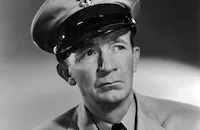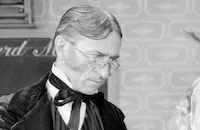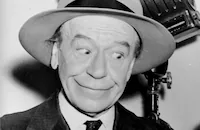The Adventures of Tom Sawyer

Brief Synopsis
Cast & Crew
Norman Taurog
Tommy Kelly
Jackie Moran
Ann Gillis
May Robson
Walter Brennan
Film Details
Technical Specs

Synopsis
Freckle-faced schoolboy Tom Sawyer, his cousin Mary, his aunt Polly and his smug half brother Sid live in a small town on the banks of the Mississippi River. Tom often gets into trouble with his strict but good-hearted aunt when Sid snitches on him or sets him up for punishment. One day, when Tom is caught playing hookey from school, Aunt Polly punishes him by giving him the tedious chore of whitewashing their fence. Tom, however, cleverly manages to convince his friends that painting is pleasurable, and they soon pay him with marbles, fishhooks and other valuables for the privilege of doing it for him. When Tom first casts his eyes upon Becky Thatcher, he falls instantly in love with her and spurns his first love, Amy Lawrence. While trying to impress Becky with his collection of "Bible tickets," which are earned for memorizing passages from Scripture, Tom purchases the tickets from his schoolmates and is exposed when he is unable to answer a simple Biblical question at the award ceremony. Later, when Mr. Dobbins, the schoolteacher, discovers an unflattering caricature of himself, drawn by someone in his class, Tom takes the blame in order to save Becky from punishment. As a result, Tom wins Becky's admiration. That evening, Tom and his half-caste friend, Huckleberry Finn, go to the local cemetery with a dead cat in order to test Huck's cure for warts. Soon after they arrive, however, they witness three townsmen, Dr. Robinson, Injun Joe and Muff Potter, the town drunk, robbing a grave. During the robbery, a dispute between the men erupts, and Injun Joe stabs and kills Dr. Robinson. In an attempt to pin the murder on the unconscious Muff, Injun Joe plants the bloodied knife in his hand and flees. Terrified by the murder they witnessed, Tom and Huck take an oath of silence and return home. After Tom is spurned by Becky and wrongly accused of spilling sugar at home, he and Huck, whose mother has forced him to wear shoes against his will, decide to run away to play pirates on Jackson Island. Tom and Huck, along with their friend, Joe Harper, dress up as pirates and play along the river, but soon learn that a search party has been dispatched to find their presumed drowned bodies following the discovery of their clothes along the riverbank. The boys camp out for three days until Tom becomes homesick and decides to sneak home in the middle of the night to spy on the grieving mothers. Tom writes a note to Aunt Polly in which he assures her of his safety and his love for her, but pockets it when he learns that his funeral services are scheduled for the following day. Tom, Huck and Joe witness their own funeral service while hiding in the church, but emerge when they become overcome with emotion. Later, at Dr. Robinson's murder trial, Huck and Tom overhear the defense attorney state that there are no witnesses to testify on Muff's behalf, which prompts the guilt-ridden Tom to come forward and tell the truth about the murder. Just as Tom is about to name Injun Joe as the real murderer, Injun Joe hurls a knife at him and flees the courtroom. Tom escapes injury, and during a school picnic at a nearby cavern, Tom, having won Becky's respect anew, takes his sweetheart on a walk through the labyrinth of underground passageways. After they find a treasure chest filled with gold in one of the corridors, Tom and Becky become lost in the cavern. While searching for an exit, Tom and Becky happen upon Injun Joe, who has been hiding in the caves, and run away from him. Meanwhile, a search party is sent into the caves when it is discovered that Tom and Becky are missing. A rockslide blocks efforts to rescue Tom and Becky, but they manage to escape death by sending Injun Joe off the side of a cliff to his death. After Tom and Becky find their way out of the caves, they meet up with the search party and are taken back to town, where they are celebrated as heroes.

Director

Norman Taurog
Cast
Tommy Kelly
Jackie Moran

Ann Gillis

May Robson

Walter Brennan

Victor Jory
David Holt

Nana Bryant
Victor Kilian

Olin Howland

Donald Meek
Charles Richman

Margaret Hamilton
Marcia Mae Jones
Mickey Rentschler
Cora Sue Collins
Philip Hurlic

Spring Byington
George Billings
Byron Armstrong
Betsy Gay
Luke Cosgrove
Frank Mcglynn
Bob Mckenzie
Roland Drew
Erville Alderson
Arthur Aylesworth
Eric Alden
Bob Murphy
Bruce Mitchell
Dan Wolheim
Frank Darien
Frank O'connor
Crew
Margaret Clancey
Roy Clark
Wilfrid M. Cline
Ben M. Cohen
Jack Cosgrove
Arden Cripe
George Cukor
Lillian K. Deighton
Lou Forbes
William Fox
James Wong Howe
Natalie Kalmus
Barbara Keon
Hal C. Kern
Neil Mcdonald
William Cameron Menzies
Marshall Neilan
Walter Plunkett
Casey Roberts
Jack Roberts
Charles Rose
David O. Selznick
Eric Stacey
John V. A. Weaver
William Wellman
Lyle Wheeler
William H. Wright

Film Details
Technical Specs

Award Nominations
Best Art Direction
Articles
The Adventures of Tom Sawyer (1938)
One of the greatest adventures for boys ever written, and Mark Twain's first full-length novel, The Adventures of Tom Sawyer was once the accepted standard of an American boyhood. Selznick's lavish adaptation was the third of at least six film versions, which included a musical featuring Jodie Foster as Becky Thatcher! Screenwriter John V. A. Weaver maintained a subtle balance between the episodic structure of the novel and the numerous characters and subplots, taking care to incorporate the most famous incidents from the book - the whitewashing of the fence, Tom's courting of Becky, the graveyard murder, and the flight through the caves. Typical of Hollywood though, Twain's original storyline was sometimes altered for dramatic reasons. For example, in the film Tom kicks Injun Joe off a precipice and he falls to his death. In the novel, Injun Joe gets lost in the cave and dies from starvation.
But The Adventures of Tom Sawyer stands as a genuine attempt to capture the true spirit of Twain's writing. The author was a creative thinker who questioned the established order of things and he used his rapier wit to attack the hypocrisy and dull conformity of his era. Unfortunately, some of the insightful humor found in the novel, such as Huck Finn introducing Tom to pipe smoking, was not used in the film for fear of outright censorship. Instead, the filmmakers placed a stronger emphasis on slapstick comedy in an effort to broaden its commercial appeal. For example, there is a running gag in the film where Sid Sawyer (David Holt) is continually pelted with a variety of slop, including whitewash, tomatoes and cake. Nevertheless, director Norman Taurog fashions a handsome entertainment from Twain's novel and the period setting is perfectly captured by William Cameron Menzies' production designs and the luminous cinematography of James Wong Howe. The art direction by Lyle Wheeler was nominated for an Oscar and equally outstanding is the veteran supporting cast that includes May Robson, Walter Brennan and Victor Jory who makes an unforgettably sinister Injun Joe.
Easily one of the dramatic highlights in the film is the cave sequence which takes on the look and feel of a claustrophobic nightmare, aided considerably by Max Steiner's evocative score. The sequence was so effective that Selznick asked Taurog to trim some of it after studying the reactions of a sneak preview audience. In Memo From David O. Selznick, the producer wrote, "¿he cave sequence was somehow too horrible for children. This worried me, because we certainly want the picture to be for a family audience....My conclusion was that this horror was not based upon the melodrama of this sequence but upon two things: the bat sequence, because of the feeling of horror of weird and flying animals; and upon what I had thought was your brilliant execution of my hysteria idea for Becky." Selznick decided the close-up of Becky laughing hysterically, her mind obviously gone, was simply too much for the kiddies. In his words, "she looks like a little witch rather than a little girl" so the horrific reaction shot was cut.
Since the death of Mark Twain, his life and his work have become a cottage industry. Documentaries, biographies, plays, and movies about him as well as the availability of previously unpublished work by the author attest to his enduring popularity. Of course, he certainly would have found all of this interesting and possibly even distasteful. Money, and its influence on people and society, was certainly one of his main concerns and the concept of great wealth stood at the center of his fictions. He had always cultivated dreams of easy riches, and then studied, through his work, the nightmare of sudden failure. Early in life, his family was cheated out of money for worthless land and this seemed to haunt him for the rest of his life. The mid-1800's was the time of the Gold Rush and the boom years that followed. Fortunes were made and lost as unpredictably as the treasure found by Tom and Huck in the cave at the end of The Adventures of Tom Sawyer. Twain himself accumulated and lost large sums of money. To Twain, money corrupted things. Indeed, the treasure found at the end of "Tom Sawyer" terrorizes Huck Finn as it did Twain.
But there is something else that resonates through Twain's novels and is also reflected in the film version of The Adventures of Tom Sawyer - laughter as an antidote against the greed, corruption and deceit he saw in the world. Laughter was his escape, his weapon. As he said in The Mysterious Stranger published posthumously in 1922, "Power, money, persuasion, supplication, persecution - these can lift at a colossal humbug - push it a little - weaken it a little, century by century, but only laughter can blow it to rags and atoms at a blast. Against the assault of laughter nothing can stand."
Producer: David O. Selznick, William H. Wright
Director: Norman Taurog
Screenplay: John V.A. Weaver, based on the novel by Mark Twain
Art Direction: William Cameron Menzies, Casey Roberts
Cinematography: Wilfred M. Cline, James Wong Howe
Editing: Margaret C. Clancey, Hal Kern
Music: Max Steiner
Cast: Tommy Kelly (Tom Sawyer), Jackie Moran (Huckleberry Finn), Ann Gillis (Becky Thatcher), May Robson (Aunt Polly), Walter Brennan (Muff Potter), Victor Jory (Injun Joe), Olin Howlin (Mr. Dobbins), David Holt (Sid Sawyer), Margaret Hamilton (Mrs. Harper), Nana Bryant (Mrs. Thatcher).
BW-93m.
by Joseph D'Onofrio

The Adventures of Tom Sawyer (1938)
Quotes
Trivia
Notes
According to Hollywood Reporter news items, producer David O. Selznick made two unsuccessful attempts to film this picture before production commenced for the third and final time on July 18, 1937. The first round of filming, which began on March 27, 1937, was suspended and then begun again on 24 Jun, only to be halted for a second time shortly thereafter. H. C. Potter directed the first two production attempts, and although it is not clear why the first two rounds of filming did not succeed, a modern source claims that Potter walked off the picture because of "Selznickian interference." Hollywood Reporter also notes that when Norman Taurog, who directed Paramount's 1931 Huckleberry Finn, took over the direction of the film, he discarded the footage that had already been shot (in black and white), and began production on the film in Technicolor. John Weaver was assigned to refurbish the script to "meet color demands."
Following Taurog's assignment as director of the picture, Ted Limes was replaced by Jackie Moran as "Huckleberry Finn," and Beulah Bondi supplanted Elizabeth Patterson as "Aunt Polly." Bondi was later replaced by May Robson. A June 28, 1937 Hollywood Reporter production chart lists A. W. Sweatt, Hugh Chapman, Jimmie Swisher, and Hollis Jewell in the cast, but their appearance in the released film is doubtful. The same production chart included Tommy Bupp in the cast but, according to an interview with Bupp, he was originally cast in the role of Tom, but when the role of Huck was given to Jackie Moran, Bupp was replaced by Tommy Kelly because Bupp was considered too tall. Hollywood Reporter news items also note that William Wellman, who was originally announced as the director of the picture, but who could not take the assignment at the time due to a schedule conflict with his work on A Star Is Born, directed two days of retakes in December 1937 while Taurog was busy with Mad About Music. George Cukor also directed some retakes and added scenes. Hundreds of boys were reportedly tested for the title role, which Selznick (according to a modern source printing of a memo he wrote on the subject) wanted to cast with an orphan who was unknown to film audiences. Selznick was unable to find a qualified orphan, but settled instead for the inexperienced Tommy Kelly, the son of an East Bronx fireman. The film marked Kelly's screen debut.
Contemporary sources note that an exhibit called "The Making of a Contemporary Film," sponsored by the Museum of Modern Art in New York, featured material that attested to the exhaustive research efforts that went into making the picture. For example, the studio's research department was said to have consulted over one hundred sources in order to insure the authenticity of the setting and the characters in the film. Among the many experts who were consulted were Bernard De Voto, H. L. Mencken and Albert Bigelow Paine. Late 19th century American school books and Missouri newspapers were also used for research purposes, as was Mark Twain's book, Life on the Mississippi. According to a February 1938 Photoplay study guide, some filming took place at Malibu Lake, CA, where a school for the twelve children who were featured in the film was run by Fletcher Clark. A Hollywood Reporter news item notes that Culver City proclaimed a "Tom Sawyer Day" in honor of this picture.
As noted in a biography of photographer James Wong Howe, many disputes arose between Howe and Technicolor cameraman Wilfred Cline over which colors should be used in the wardrobe and sets. Cline suggested brilliant primary colors, while Howe insisted that the film maintain its true Southern and rural flavor by using only subdued earth tones. Howe prevailed, but by the end of the first week of production, the two were reportedly no longer on speaking terms. The biography also notes that while shooting the cave sequences, Howe overcame lighting difficulties by strapping Kelly to a harness that carried a 10,000 watt globe of light with an electrical cord running down the actor's leg. The device created the desired effect of Kelly lighting his path with a giant candle. In addition, Howe's biography notes that the Technicolor company, which had a virtual monopoly on color production, banned Howe from shooting subsequent pictures in color due to his poor rapport with their company. (Howe did not film another color production until 1949).
According to a Hollywood Reporter news item, Selznick International made a separate print of the film for release in Great Britain. William Hamilton Burnside, an English sales consultant, helped the studio eliminate "American colloquialisms, dialogue and situations in the Missouri boy story that might not be understood by a British audience." The New York Times review of the film ends with the reviewer stating: "...get busy [Mr. Selznick] on Gone With the Wind, will you, before we begin throwing tomatoes." Lyle Wheeler was nominated for an Academy Award for Best Art Decoration for his work on the film.
Other films based on Twain's novel include: the 1917 Paramount film Tom Sawyer, directed by William D. Taylor and starring Jack Pickford and George Hackathorne (see AFI Catalog of Feature Films, 1911-20; F1.4513); the 1930 Paramount-Publix film of the same title, directed by John Cromwell and starring Jackie Coogan and Junior Durkin (see below); the 1938 Paramount film Tom Sawyer, Detective (see AFI Catalog of Feature Films, 1931-40; F3.4677); the 1973 Universal TV-Hal Roach Productions telefilm, directed by James Neilson and starring Jane Wyatt and Buddy Ebsen, which aired on the CBS television network on March 23, 1973; the 1973 United Artists musical film Tom Sawyer, directed by Don Taylor; and, the 1995 Walt Disney Company film entitled Tom and Huck, directed by Peter Hewitt and starring Jonathan Taylor Thomas and Brad Renfro.

Miscellaneous Notes
Released in United States Winter February 17, 1938
Released in United States 1974
Released in United States Winter February 17, 1938
Released in United States 1974 (Shown at FILMEX: Los Angeles International Film Exposition (A Tribute to the Art of Cinematography) March 28 ¿ April 9, 1974)













